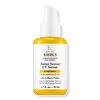What's inside
What's inside
 Key Ingredients
Key Ingredients

 Benefits
Benefits

 Concerns
Concerns

 Ingredients Side-by-side
Ingredients Side-by-side

Butyl Methoxydibenzoylmethane 3%
UV AbsorberHomosalate 7%
Skin ConditioningEthylhexyl Salicylate 5%
UV AbsorberOctocrylene 7%
UV AbsorberWater
Skin ConditioningGlycerin
HumectantC15-19 Alkane
SolventPropanediol
SolventC12-22 Alkyl Acrylate/Hydroxyethylacrylate Copolymer
StabilisingTocopherol
AntioxidantSodium Stearoyl Glutamate
CleansingButylene Glycol
HumectantCetearyl Alcohol
EmollientSclerotium Gum
Emulsion StabilisingHydroxyacetophenone
AntioxidantCaprylyl Glycol
EmollientSodium Starch Octenylsuccinate
AbsorbentGlyceryl Stearate
EmollientJojoba Esters
EmollientHelianthus Annuus Seed Wax
Skin ConditioningHydroxypropyl Starch Phosphate
Trisodium Ethylenediamine Disuccinate
Carbomer
Emulsion StabilisingSodium Lactate
BufferingSodium Hydroxide
BufferingPolysorbate 20
EmulsifyingPolyglycerin-3
HumectantPalmitoyl Tripeptide-1
Skin ConditioningPalmitoyl Tetrapeptide-7
Skin ConditioningButyl Methoxydibenzoylmethane 3%, Homosalate 7%, Ethylhexyl Salicylate 5%, Octocrylene 7%, Water, Glycerin, C15-19 Alkane, Propanediol, C12-22 Alkyl Acrylate/Hydroxyethylacrylate Copolymer, Tocopherol, Sodium Stearoyl Glutamate, Butylene Glycol, Cetearyl Alcohol, Sclerotium Gum, Hydroxyacetophenone, Caprylyl Glycol, Sodium Starch Octenylsuccinate, Glyceryl Stearate, Jojoba Esters, Helianthus Annuus Seed Wax, Hydroxypropyl Starch Phosphate, Trisodium Ethylenediamine Disuccinate, Carbomer, Sodium Lactate, Sodium Hydroxide, Polysorbate 20, Polyglycerin-3, Palmitoyl Tripeptide-1, Palmitoyl Tetrapeptide-7
Water
Skin ConditioningIsoamyl Laurate
EmollientAlcohol Denat.
AntimicrobialPolyester-8
Skin ConditioningBis-Ethylhexyloxyphenol Methoxyphenyl Triazine
Skin ConditioningPhenylbenzimidazole Sulfonic Acid
UV AbsorberButyl Methoxydibenzoylmethane
UV AbsorberPhenyl Trimethicone
Skin ConditioningCaprylyl Methicone
Skin ConditioningPropanediol
SolventAluminum Starch Octenylsuccinate
AbsorbentEthylhexyl Triazone
UV AbsorberSodium Hydroxide
BufferingAcrylates/C12-22 Alkyl Methacrylate Copolymer
PEG-40 Hydrogenated Castor Oil
EmulsifyingHydroxyacetophenone
AntioxidantAcrylates Copolymer
Phenoxyethanol
PreservativeNiacinamide
SmoothingDisodium Lauriminodipropionate Tocopheryl Phosphates
CleansingHydrolyzed Adansonia Digitata Seed Extract
Hydrolyzed Soy Protein
HumectantRice Amino Acids
Skin ConditioningProline
Skin ConditioningArginine
MaskingCoco-Glucoside
CleansingDisodium Lauryl Sulfosuccinate
CleansingAscorbyl Glucoside
AntioxidantHydroxystearic Acid
CleansingWater, Isoamyl Laurate, Alcohol Denat., Polyester-8, Bis-Ethylhexyloxyphenol Methoxyphenyl Triazine, Phenylbenzimidazole Sulfonic Acid, Butyl Methoxydibenzoylmethane, Phenyl Trimethicone, Caprylyl Methicone, Propanediol, Aluminum Starch Octenylsuccinate, Ethylhexyl Triazone, Sodium Hydroxide, Acrylates/C12-22 Alkyl Methacrylate Copolymer, PEG-40 Hydrogenated Castor Oil, Hydroxyacetophenone, Acrylates Copolymer, Phenoxyethanol, Niacinamide, Disodium Lauriminodipropionate Tocopheryl Phosphates, Hydrolyzed Adansonia Digitata Seed Extract, Hydrolyzed Soy Protein, Rice Amino Acids, Proline, Arginine, Coco-Glucoside, Disodium Lauryl Sulfosuccinate, Ascorbyl Glucoside, Hydroxystearic Acid
 Reviews
Reviews

Ingredients Explained
These ingredients are found in both products.
Ingredients higher up in an ingredient list are typically present in a larger amount.
Also known as Avobenzone, this ingredient is a chemical sunscreen filter that provides protection in the UV-A range.
Avobenzone is globally approved and is the most commonly used UV-A filter in the world.
Studies have found that avobenzone becomes ineffective when exposed to UV light (it is not photostable; meaning that it breaks down in sunlight). Because of this, formulations that include avobenzone will usually contain stabilizers such as octocrylene.
However, some modern formulations (looking at you, EU!) are able to stabilize avobenzone by coating the molecules.
Avobenzone does not protect against the UV-B range, so it's important to check that the sunscreen you're using contains other UV filters that do!
The highest concentration of avobenzone permitted is 3% in the US, and 5% in the EU.
Learn more about Butyl MethoxydibenzoylmethaneHydroxyacetophenone is antioxidant with skin conditioning and soothing properties. It also boosts the efficiency of preservatives.
This ingredient is not irritating or sensitizing.
Propanediol is an all-star ingredient. It softens, hydrates, and smooths the skin.
It’s often used to:
Propanediol is not likely to cause sensitivity and considered safe to use. It is derived from corn or petroleum with a clear color and no scent.
Learn more about PropanediolSodium Hydroxide is also known as lye or caustic soda. It is used to adjust the pH of products; many ingredients require a specific pH to be effective.
In small amounts, sodium hydroxide is considered safe to use. However, large amounts may cause chemical burns due to its high alkaline.
Your skin has a natural pH and acid mantle. This acid mantle helps prevent harmful bacteria from breaking through. The acid mantle also helps keep your skin hydrated.
"Alkaline" refers to a high pH level. A low pH level would be considered acidic.
Learn more about Sodium HydroxideWater. It's the most common cosmetic ingredient of all. You'll usually see it at the top of ingredient lists, meaning that it makes up the largest part of the product.
So why is it so popular? Water most often acts as a solvent - this means that it helps dissolve other ingredients into the formulation.
You'll also recognize water as that liquid we all need to stay alive. If you see this, drink a glass of water. Stay hydrated!
Learn more about Water